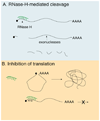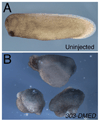The use of antisense oligonucleotides in Xenopus oocytes
- PMID: 20045732
- PMCID: PMC2868083
- DOI: 10.1016/j.ymeth.2009.12.015
The use of antisense oligonucleotides in Xenopus oocytes
Abstract
The ability to manipulate gene expression in Xenopus oocytes and then generate fertilized embryos by transfer into host females has made it possible to rapidly characterize maternal signaling pathways in vertebrate development. Maternal mRNAs in particular can be efficiently depleted using antisense deoxyoligonucleotides (oligos), mediated by endogenous RNase-H activity. Since the microinjection of antisense reagents or mRNAs into eggs after fertilization often fails to affect maternal signaling pathways, mRNA depletion in the Xenopus oocyte is uniquely suited to assessing maternal functions. In this review, we highlight the advantages of using antisense in Xenopus oocytes and describe basic methods for designing and choosing effective oligos. We also summarize the procedures for fertilizing cultured oocytes by host-transfer and interpreting the specificity of antisense effects. Although these methods can be technically demanding, the use of antisense in oocytes can be used to address biological questions that are intractable in other experimental settings.
Figures



Similar articles
-
Oocyte Host-Transfer and Maternal mRNA Depletion Experiments in Xenopus.Cold Spring Harb Protoc. 2018 Oct 1;2018(10):pdb.prot096982. doi: 10.1101/pdb.prot096982. Cold Spring Harb Protoc. 2018. PMID: 29321286 Free PMC article.
-
Controlling the Messenger: Regulated Translation of Maternal mRNAs in Xenopus laevis Development.Adv Exp Med Biol. 2017;953:49-82. doi: 10.1007/978-3-319-46095-6_2. Adv Exp Med Biol. 2017. PMID: 27975270 Free PMC article. Review.
-
Maternal mRNA knock-down studies: antisense experiments using the host-transfer technique in Xenopus laevis and Xenopus tropicalis.Methods Mol Biol. 2012;917:167-82. doi: 10.1007/978-1-61779-992-1_10. Methods Mol Biol. 2012. PMID: 22956088 Free PMC article.
-
How the mother can help: studying maternal Wnt signaling by anti-sense-mediated depletion of maternal mRNAs and the host transfer technique.Methods Mol Biol. 2008;469:417-29. doi: 10.1007/978-1-60327-469-2_26. Methods Mol Biol. 2008. PMID: 19109723
-
Xenopus oocytes as a heterologous expression system for plant proteins.Mol Biotechnol. 1995 Apr;3(2):101-15. doi: 10.1007/BF02789106. Mol Biotechnol. 1995. PMID: 7620971 Review.
Cited by
-
Manipulation and in vitro maturation of Xenopus laevis oocytes, followed by intracytoplasmic sperm injection, to study embryonic development.J Vis Exp. 2015 Feb 9;(96):e52496. doi: 10.3791/52496. J Vis Exp. 2015. PMID: 25742326 Free PMC article.
-
Role of maternal Xenopus syntabulin in germ plasm aggregation and primordial germ cell specification.Dev Biol. 2017 Dec 15;432(2):237-247. doi: 10.1016/j.ydbio.2017.10.006. Epub 2017 Oct 14. Dev Biol. 2017. PMID: 29037933 Free PMC article.
-
Oocyte Host-Transfer and Maternal mRNA Depletion Experiments in Xenopus.Cold Spring Harb Protoc. 2018 Oct 1;2018(10):pdb.prot096982. doi: 10.1101/pdb.prot096982. Cold Spring Harb Protoc. 2018. PMID: 29321286 Free PMC article.
-
Differential role of STIM1 and STIM2 during transient inward (T in) current generation and the maturation process in the Xenopus oocyte.BMC Physiol. 2014 Nov 15;14:9. doi: 10.1186/s12899-014-0009-x. BMC Physiol. 2014. PMID: 25399338 Free PMC article.
-
Controlling the Messenger: Regulated Translation of Maternal mRNAs in Xenopus laevis Development.Adv Exp Med Biol. 2017;953:49-82. doi: 10.1007/978-3-319-46095-6_2. Adv Exp Med Biol. 2017. PMID: 27975270 Free PMC article. Review.
References
Publication types
MeSH terms
Substances
Grants and funding
LinkOut - more resources
Full Text Sources

